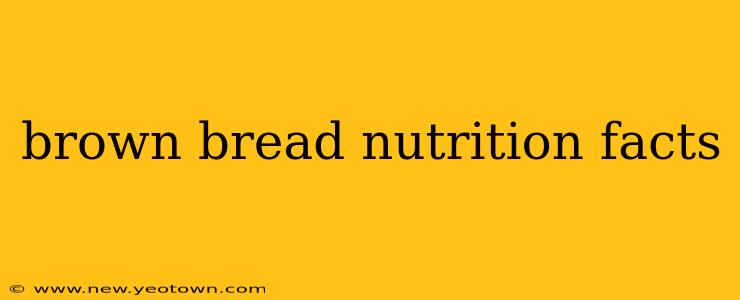Brown bread. The very words conjure images of hearty meals, rustic charm, and wholesome goodness. But beyond the comforting aroma and satisfying texture lies a nutritional powerhouse often underestimated. This isn't just any bread; it's a staple brimming with fiber, vitamins, and minerals that play a crucial role in maintaining good health. Let's unravel the nutritional secrets within this everyday food and discover why it deserves a prominent place in your diet.
My name is Amelia Stone, and I've spent years researching the nutritional value of everyday foods. I believe in empowering people with knowledge to make informed choices about their diet, and brown bread is a perfect example of a food with hidden depths.
What are the Nutritional Benefits of Brown Bread?
Brown bread's nutritional profile is significantly richer than its white counterpart. The key difference lies in the type of flour used. Brown bread is typically made with whole-wheat flour, retaining the bran and germ—parts of the wheat kernel that are stripped away in white bread production. This makes all the difference. These components are packed with essential nutrients that significantly contribute to our overall well-being.
Let's delve into the specifics:
-
Fiber: This is arguably the most significant benefit. Brown bread boasts a high fiber content, primarily insoluble fiber from the bran. This type of fiber promotes healthy digestion, prevents constipation, and helps regulate blood sugar levels. It also contributes to feelings of fullness, aiding in weight management.
-
Vitamins and Minerals: Whole wheat flour retains vital vitamins and minerals, such as iron, magnesium, selenium, and B vitamins (like thiamin and niacin). These nutrients are crucial for various bodily functions, including energy production, immune system support, and nerve function.
-
Antioxidants: The bran and germ in whole wheat flour are also excellent sources of antioxidants, which combat free radicals in the body and help protect against cell damage.
What is the Difference Between Brown Bread and Whole Wheat Bread?
This is a common question, and the answer is nuanced. While often used interchangeably, there's a subtle but important distinction.
Whole wheat bread is made entirely from whole wheat flour, including the bran, germ, and endosperm.
Brown bread, on the other hand, can be made with a blend of whole wheat flour and refined flour. While it often appears darker and thus healthier than white bread, it might not always contain the same level of nutrients as 100% whole wheat bread. Always check the ingredients list to ensure you're selecting a bread with a high percentage of whole wheat flour.
How Many Calories are in a Slice of Brown Bread?
The calorie count in brown bread varies depending on the brand, size of the slice, and added ingredients. A typical slice (around 30-40g) contains between 70-100 calories. However, this can fluctuate, so always check the nutritional information on the specific product's packaging.
Is Brown Bread Good for Weight Loss?
The high fiber content in brown bread contributes to feelings of satiety, which can indirectly support weight loss efforts. Fiber helps regulate blood sugar levels, preventing energy crashes that often lead to overeating. However, brown bread shouldn't be considered a magical weight-loss food. A balanced diet and regular exercise remain crucial components of a successful weight loss strategy.
What are the Different Types of Brown Bread?
The world of brown bread extends beyond the basic loaf. You'll find various types, each with its unique flavor and texture. Some examples include:
- Sourdough Brown Bread: Fermented using a sourdough starter, providing a tangy flavor and improved digestibility for some individuals.
- Rye Brown Bread: Incorporating rye flour, offering a denser texture and a slightly nutty flavor.
- Multigrain Brown Bread: A blend of different grains, enriching the nutritional profile and adding textural complexity.
Conclusion: Embracing the Goodness of Brown Bread
Brown bread is more than just a carbohydrate source; it's a nutritional powerhouse packed with fiber, vitamins, and minerals vital for overall well-being. While it's not a miracle food, incorporating it into a balanced diet can contribute significantly to digestive health, blood sugar regulation, and overall energy levels. Remember to check the ingredients list to ensure you're selecting a bread made with a high percentage of whole wheat flour, maximizing the nutritional benefits. So next time you're reaching for bread, reach for the brown variety – your body will thank you.

